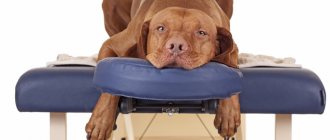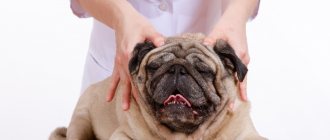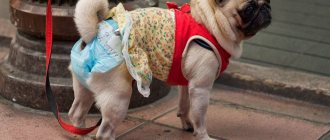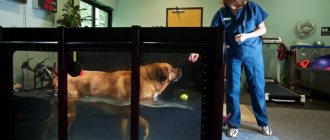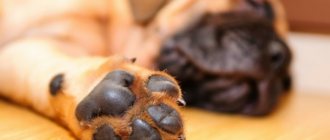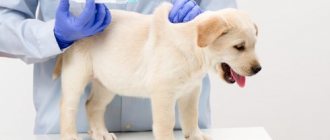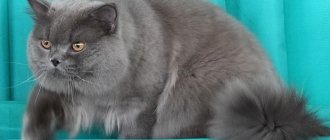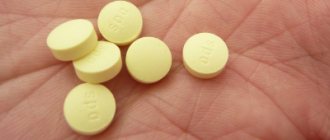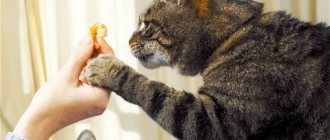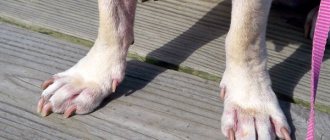Muscles of the hip joint Exercises for developing the muscles of the pelvic limb in dogs The muscles of the pelvic limb consist of the muscles of the hip joint, the femoral group of muscles, the muscles of the knee and hock joints, and the muscles of the fingers. A number of exterior indicators depend on the structure of the pelvic limb - stance, topline, shin length. The nature of the dog's movement is determined primarily by the pelvic limbs. In order to correctly select the necessary exercises to strengthen the hind legs, improve their condition, and prevent possible injuries (especially in sporting dogs), it is necessary to have a very good understanding of the dog’s anatomy and the biomechanics of its movement.
Causes of hind leg paralysis
Many factors have been identified that lead to the development of paralysis of a pet's hind legs. Among them are:
- traumatic injuries . Any fractures, sprains and tendon ruptures can not only significantly limit the dog’s motor activity, but also damage peripheral nerve fibers. As a result, innervation is disrupted and paralysis develops;
- neoplasms . Malignant and benign tumors affect the nervous system in 4% of cases. Any localization of the proliferative process (in the brain and spinal cord, not in the periphery) can disrupt the functions of the nerve trunks. Also, impulse conduction can be changed when nerve tissue is compressed by nearby pathological foci;
- joint diseases – arthritis, arthrosis;
Arthritis and arthrosis
- spinal pathologies . Herniated intervertebral discs, discopathy, and scoliosis disrupt the normal anatomy of the spinal canal, during which the spinal cord can be compressed in any area and the innervation ceases. The higher the localization of the lesion, the more organs lose their function. For example, damage to the thoracic or lumbar spinal cord leads to denervation of the pelvic organs;
- degenerative bone diseases. Spondylosis (spike-like growth of vertebral tissue towards the spinal cord), spondyloarthrosis (protrusion of the annulus pulposus of the spinal disc), discopathy (penetration of disc components into the brain canal) provoke compression of nerve cells. Against the background of long-term adverse effects, adequate oxygen supply is disrupted and nerve tissues die;
Spondyloarthrosis on x-ray
- unsuccessful movements . Prolapse of spinal discs, dislocations and fractures of various parts of the axial bone formation can occur with excessively active movements and unsuccessful turns;
- allergic polyneuropathy . Allergopathology can affect any organs, including the nervous system. Deviations occur when exposed to any allergens: household, medicinal, food, etc.;
- viral and bacterial infections affecting the spinal cord or brain (myelitis, meningitis, encephalitis, etc.). Not only damage to nerve fibers with the development of edema and destruction in them is dangerous, but also the action of poisons and toxins of pathogens;
- ischemic and hemorrhagic strokes . Pathology can occur due to various reasons: atherosclerotic damage to the vessels of the central nervous system, stress in the dog, increased blood pressure, massive injuries. As a result, a specific part of the nervous system is shut down.
Compression of the contents of the spinal canal
Which breeds get sick more often?
The disease usually affects medium and small breeds. Dachshunds, Brabançons, Pekingese and French bulldogs have a hereditary predisposition to intervertebral disc disease. Isolated discopathy is usually characteristic of very large breeds in old age. These include Doberman Pinschers, German Shepherds and Rottweilers. The deviation can progress throughout life and not appear at all.
Different dog breeds are prone to different types of paralysis
Pathologies of the musculoskeletal system are more common in shepherd dogs, Labradors, Great Danes and St. Bernards. The main reason is hip dysplasia, caused by the intensive growth of the animal’s body in the period from 4 to 10 months. Small breeds of dogs are prone to increased trauma. Typically, animals' paws suffer from minor falls, car injuries, and conflicts with representatives of other breeds.
Bulldogs have a hereditary predisposition to intervertebral disc diseases
How does the articular-ligamentous apparatus of a dog work?
- Articular surface.
- Joint capsule.
- Joint cavity.
The joints are divided:
- simple (shoulder, hip),
- complex (carpal, tarsal),
- combined (elbow),
- complex (temporomandibular, knee).
- uniaxial (ulnar, carpal, metacarpophalangeal, interphalangeal, tarsal),
- biaxial (knee),
- multi-axial (shoulder, hip).
Ligaments are divided:
- Guides.
- Retaining.
- Extracapsular.
- Capsule.
- Intracapsular.
Classification of paralysis
The disease is always associated with damage to the nervous system. Depending on the severity of the deviation, scientists systematize it as follows:
- monoplegia - paralysis of one leg;
- paraplegia - the lesion involves the front or hind limbs;
- tetraplegia – lack of innervation of all paws;
- hemiplegia – the right or left half of the body is immobilized;
Depending on the severity of damage to the central and peripheral nervous system and etiology, there are:
- functional paralysis . Occurs against the background of exposure to negative factors (toxins, swelling, stress). The phenomenon disappears after the cause is eliminated;
- organic paralysis . The basis is damage to neurons, the function will never be restored. Often the cause is trauma, tumors, and irreversible infectious and inflammatory processes.
Paraplegia in a dog
Localization is an important diagnostic sign. Paralysis occurs:
- central (the brain and spinal cord are affected);
- peripheral (deviations are detected from the peripheral nerve fibers).
They also highlight:
- paralysis (decreased muscle strength with limitation of motor and functional activity);
- paresis (complete impossibility of movement).
Massage for the sake of salvation - indirect heart
In emergency situations, an indirect cardiac massage can save a pet’s life, which is performed as follows:
- The dog is placed on its right side. The animal's head is placed so that it is lower than the body.
- The palms of the hands are placed crosswise (one on top at a right angle) on the chest behind the animal’s elbow on the right side.
- Massage the chest with short and strong jerking movements.
- There are 100 pushes per minute.
- Every 15 - 20 seconds they resort to ventilation of the lungs by artificial respiration (air is blown into the animal’s nose with force).
In this article I will talk about how to properly massage a dog’s feet. I’ll explain why you need to massage your dog’s paws, and how to treat him if his hind limbs fail. I will give the main reasons for problems with the hind limbs.
Symptoms of the disease
Dragging paws behind you
Clinical manifestations may vary. The rate of development of pathology also differs significantly. In some cases, the disease progresses quickly (injuries), leading to disability of the animal within a few minutes, in others it lasts for years (tumors, discopathy, etc.) The following main symptoms can be identified:
- loss of ability to move independently. The dog can walk while leaning on walls or other interior objects. In isolated forms, one or more limbs may drag after the dog along the floor or ground;
- unsteadiness of gait. The animal moves uncertainly, staggering;
- frequent stumbling. Weakened or absent muscle strength leads to decreased range of motion. The pet touches any small obstacles - stones, carpets, thresholds. An additional danger is introduced by the possibility of injury and infection (in denervated areas the immune system does not function adequately, creating a favorable environment for the proliferation of microorganisms);
- asymmetry of the body and limbs. Paralysis or paresis leads to the impossibility of movement, decreased muscle tone, which disrupts the functional and aesthetic anatomy of the animal.
Unsteady gait as a sign of paralysis
When the pain syndrome is severe, the animal is restless and rushes around the room, even if this is not completely successful. In rare cases, if the lesion is in the brain, the disease is combined with attacks of convulsive seizures. They can be limited (one limb twitches) or generalized (convulsions cover the entire body). Systemic convulsions are a dangerous phenomenon, since during them the animal’s breathing stops due to spasm of the circulatory fibers of the larynx.
Diagnostics
Statistics show that dog owners turn to veterinarians for help even when the animal completely loses the ability to move independently and causes a lot of inconvenience. In diagnosis, it is extremely important to know the duration of the disease (for example, various viral infections have their own developmental characteristics and different incubation periods).
A visual examination allows you to immediately make a correct diagnosis. The veterinarian checks the integrity of deep and superficial sensitivity and identifies reflex pathologies.
Paralysis of both hind legs is not difficult to detect
However, the cause of the pathology is extremely important, since treatment will be aimed specifically at it. The dog undergoes a whole range of laboratory and instrumental activities:
- general blood test (an increase in the level of leukocytes and neutrophilia will indicate the bacterial nature of the infection, and leukopenia in combination with an increase in the number of lymphocytes indicates a viral infection);
- biochemical study of blood composition (rheumatic factors are especially important, allowing one to judge the autoimmune process);
- specific tests to search for antibodies to pathogens;
- ultrasound examination of the extremities (allows you to visualize the lesion, identify swelling and the current location of nerve fibers);
- X-ray is the best method for diagnosing fractures and bone deformities;
- CT or MRI (methods provide a complete picture of what is happening in the central and peripheral nervous system of the dog and allow, in almost 98% of cases, to make the correct diagnosis).
Video - Failure of hind legs in dogs
Complications
Paralysis can lead to other more serious consequences and further aggravate the general condition. These include the following:
- rapid muscle atrophy . Muscles that have lost their mass find it more difficult to become active. Therefore, without massage and physiotherapeutic procedures, the animal will never return to its normal life;
- the appearance of contractures . If the pet does not make passive movements, imitating physiological ones, then the joints gradually ossify;
- bedsores _ A long-term immobile position contributes to the appearance of areas of necrosis on tissues in contact with the floor;
- development of other diseases . Physical inactivity leads to hypostatic pneumonia and an increased risk of blood clots, which can cause death.
Treatment
Treatment tactics depend, first of all, on the etiology of the disease. If the cause of the deviations is fractures, dislocations or ligament ruptures, then the limb is immobilized with a plaster cast or tight bandage for a certain time (usually 3-6 weeks).
How to recognize a fracture in a dog
Neoplasms are subject to surgical excision, followed by chemotherapy to prevent the growth of metastases and tumor recurrence. In some situations where cell proliferation is unresectable, palliative radiotherapy may be prescribed. The lesion is exposed to X-rays that destroy the tumor.
For bacterial or viral infectious and inflammatory processes, antimicrobial and antiviral agents are prescribed. The dosage regimen is indicated in the table.
Table 1. Drug treatment of infections due to paralysis in dogs
| Name | Dosage | Frequency of application | Duration of treatment | Spectrum of action | Method of administration |
| Amoxicillin | 20 mg/kg | 2 times a day | 4-8 days | Bacteria | With food |
| Azithromycin | 4 mg/kg | Every 24 hours | 10 days | Bacteria | With food |
| Neomycin | 15 mg/kg | 1 per day | 10 days | Bacteria | With food |
Ribotan | 2 ml | Every 8-12 hours | 3-5 days | Viruses | Subcutaneous/intramuscular |
Spinal lesions, as a rule, are not radically corrected and are subject to symptomatic therapy. An excellent tool for reducing the activity of the inflammatory process (especially of an autoimmune nature) are systemic glucocorticosteroids. For example, Methylprednisolone (1 mg/kg 2 times a day).
In order to reduce the severity of pain, the use of non-narcotic analgesics is indicated. Nonsteroidal anti-inflammatory drugs are excellent: Ketonal (1 mg/kg body weight per day), Vedaprofen (0.5 mg/kg 2 times a day, but not more than 10 mg per day). This group of drugs has not only an analgesic, but also an anti-inflammatory effect, helping to reduce and delineate the source of inflammation. The duration of treatment, for safety reasons, should not exceed 14 days.
The drug Ketonal in capsules
Increased load on the muscles due to impaired innervation of the limbs always leads to muscle overload. Antispasmodics are indicated to reduce spasm and tension. The banal No-shpa or Baralgin . Dose – 1 tablet per 10 kg of dog weight per day. The course of treatment is until the symptoms disappear completely.
Baralgin tablets
The doctor can also prescribe multivitamin preparations that necessarily contain B1, B12 and PP. One of these medications is the vitamin supplement “Vitamins”. The duration of therapy is 2 months, and the daily dose for a weight less than 10 kg is 3 tablets, from 10 to 20 kg - 5-6, from 30 to 40 - 7-8, and for a body weight over 40 kg - 10 tablets.
Attention! The use of any drug should be carried out only after consultation with a veterinarian on his recommendation. Self-treatment without undergoing examination in a clinic is fraught with life-threatening consequences.
Types of procedure
In veterinary practice, the following types of manual procedures in dogs are distinguished:
- Preventive
. Massage allows you to relax your muscles, increase muscle tone, and has a warming effect. - Medicinal.
It is an integral part of the therapeutic course. It is usually prescribed for arthrosis, degenerative pathologies of the vertebrae, sprains, and bone fractures. - Aqua massage. It is a type of medicinal. Carried out in a specialized clinic. The animal is placed in a container with bubbling warm water. This hydromassage improves blood circulation, tissue nutrition, and has a tonic and restorative effect on the pet’s body.
- Wellness.
Regular procedures during the rehabilitation period are designed to return the pet to normal life as soon as possible. Restorative massage is used after paresis and paralysis in dogs, and after surgery on the musculoskeletal system. - Cosmetic.
The procedure is carried out in beauty salons for animals in order to improve the aesthetic appearance of the coat. During the manipulation, special products are used - aromatic oils, fortified powders, etc.
Prevention
Any disease can be prevented. To prevent your pet from encountering such a serious problem, you should follow a few simple rules:
- early activation of the animal. From 1-2 months he should be allowed outside and allowed frequent contact with dogs of his age;
From the first months, it is important to accustom puppies to an active lifestyle.
- making time for rest. If your pet wants to sleep, do not disturb him;
- prevention of going down stairs until six months of age. It is better to carry small puppies in your arms, this will prevent injuries and fractures;
- undergo regular examination (including x-rays) for breeds at high risk of paralysis;
- adherence to diet. The food entering the dog’s body must be complete in qualitative and quantitative proportions, given in accordance with the preferences of the breed and age;
- exclude exposure to cold (air conditioning, tiles, drafts). The animal's permanent place of residence must be warm;
- regular sanitary cleaning and washing of all pet’s personal belongings without the use of hazardous chemicals.
Once every six months, the dog must be taken to the veterinarian for examination.
Procedure techniques
As a rule, manual therapy is performed on an animal in a specialized salon, veterinary clinic or at home. The preparatory stage includes organizing the location for the procedure. It is best to place your pet on a hard, flat surface, first covering it with a soft cloth. An aggressive patient must be muzzled.
The technique is based on the following basic movements: stroking (light and flat), kneading, shaking, vibration movements, rubbing and effleurage. Stroking begins and ends each session.
It is best to carry out the manipulation with your fingertips or the width of your palm. Stroking movements promote relaxation, muscle relaxation, and calm the animal. With their help, contact is established with the four-legged patient.
Kneading involves first soothing movements and then stimulating ones. On a small surface, kneading should be done with the thumbs, and when massaging large parts of the body, with the palmar surface of the tips of the index, middle and ring fingers. The technique involves moving your fingers in a circle.
To activate blood circulation in any treatment complex, shaking is used. In order to influence deep-lying muscles and ligaments, the massage therapist performs a vibration technique. Oscillatory movements are performed in a calm rhythm.
Increases blood flow, eliminates adhesions in tissues by rubbing. This massage technique is most effective for diseases of the musculoskeletal system. Effleurage is used to relieve stress, supply tissues with oxygen, and stimulate large muscles and parts of the body.
Massage of front and hind legs for paralysis
If a pet has paralysis of the limbs, massage is prescribed, as a rule, in the rehabilitation phase of the disease. During the procedure, well-known techniques are used. Kneading and vibration should be the main elements.
The hind and front paws are massaged from top to bottom. The effectiveness of manual therapy depends not only on proper technique, but also on frequency. It is important to regularly carry out a health complex on sore limbs.
The duration of the procedure is at least 15 - 20 minutes. The course consists of 15 - 20 sessions. After this, the animal is given a break of 10-14 days and treatment is resumed.
Relaxing for back, ears, head
The relaxation complex should begin with stroking the entire body of the pet. After the dog relaxes, you can begin to make circular movements in the neck area. Considering the direction of the lymphatic vessels, hand movements should be directed downwards - from the head to the chest. When applying manual pressure to your pet's neck and head, you should be careful - do not put pressure on the trachea and pharynx, reduce the pressure under the ears to avoid injury to the lymph nodes.
Apply circular movements to the neck, shoulders and sides of the animal, gradually moving towards the tail. They carefully make clockwise and counterclockwise movements (three times).
Experienced specialists perform manipulations to stretch the tail, which has a strong relaxing effect on the pet. It is not recommended for an inexperienced owner to perform this technique on their own. At the end of the relaxing procedure, the dog's body is stroked with long movements - from the head to the croup and back.
Massage with the aim of relaxing and calming your pet can be performed not only with your hand. For short-haired pets, it is convenient to perform a manual procedure using a suede glove worn on the hand. For hairless breeds, a silk scarf is more suitable to prevent electrification of the fur.
What to do for constipation
In case of such a problem as constipation in a dog, in addition to following a diet, abdominal massage has a good effect. Most often, the owner resorts to this procedure in puppies and young animals. Massaging circular movements are carried out near the navel.
If manipulation is intended to be performed on an adult dog, it must be remembered that intrusion into the groin area may not be to the animal’s liking. In this regard, it is better to first do a 5-minute relaxing complex and only then gradually move on to the effect on the abdominal area.
To learn how to massage dogs with spinal problems, watch this video:
